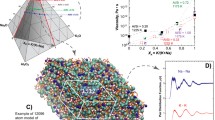Abstract
A theoretical analysis and computer modelling of quartz gives a picture of the α−β phase transition in terms that would appear to be widely applicable to other silicate framework structures. The picture is based upon the fact that the structure of the β-phase can distort to the α form through the rotations of the SiO4 tetrahedra without necessitating any distortions of the individual tetrahedra. A simple model based upon this premise and augmented by lattice energy calculations of the ordering potential gives a value for the phase transition temperature that is in semi-quantitative agreement with experiment. The reasons for the success of this model are then explored using a full anharmonic lattice dynamics calculation of the phase transition using renormalised phonon theory, highlighting the particular significance of the soft phonon branch compared to all the other phonon branches. The basic picture also explains the variation of the transition temperature with cation concentration in other aluminosilicates, and gives further insight into the validity of the mean-field description in these phase transitions.
Similar content being viewed by others
Author information
Authors and Affiliations
Additional information
Received: 10 May 1998 / Revised, accepted: 25 July 1998
Rights and permissions
About this article
Cite this article
Dove, M., Gambhir, M. & Heine, V. Anatomy of a structural phase transition: theoretical analysis of the displacive phase transition in quartz and other silicates. Phys Chem Min 26, 344–353 (1999). https://doi.org/10.1007/s002690050194
Issue Date:
DOI: https://doi.org/10.1007/s002690050194




